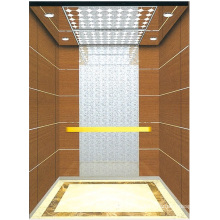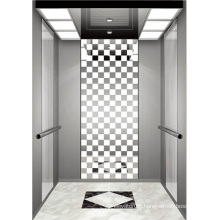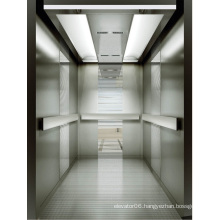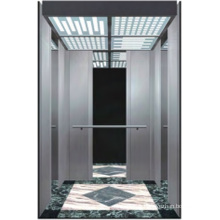Elevator safety clamp working principle and inspection points - Solutions - Huaqiang Electronic Network
2021-05-02
Safety gear is an important safety component of elevator equipment. It can play an important role in the safety of elevators when it is overspeed and out of control. It can be said that it is because of the emergence and development of safety gear that the elevator becomes an essential vertical for high-rise buildings. Transportation. However, due to the complicated and variable causes of the safety gear, and the factors that cause its malfunction, there are certain safety hazards, which may bring serious consequences to the elevator and passengers. I have been engaged in elevator inspection and testing and technical quality management for many years. I often encounter some problems worthy of discussion. Now I will discuss the safety inspection tools and common faults of safety clamps in the inspection and inspection to ensure safe and efficient operation of the elevator. Safety Clamp Device Principle The action of the safety gear device is to clamp the speed limiter rope by the speed limiter action. As the car moves downward, the speed limiter rope pulls the safety clamp link mechanism and the safety clamp link. The action of the mechanism drives the safety clamp brake element to contact with the guide rail, so that the safety clamps on both sides of the guide rail are simultaneously clamped on the guide rail to achieve the car stop. The structural schematic diagram is shown in Figure 1. The safety gear is generally installed on the car bottom beam or the two side columns, and is mainly composed of a clamp seat, a wedge block, a lifting rod and a pulling mechanism mounted on the upper beam of the car. At the same time, the corresponding safety switch device operates to stop the traction machine from rotating. When the safety gear does not move, the wedge and the working surface of the guide rail maintain a clearance of 2 to 3 mm. The clearance on both sides of the safety clamp should be even, and the car can be reliably stopped on the guide rail during operation. The safety gage inspection focus As mentioned above, the elevator safety pliers have certain safety hazards, which requires installation, maintenance and use of the unit to regularly repair, adjust, and replace the failed parts in time to eliminate hidden dangers. In general, in addition to the speed limiter-safety gear linkage test during the inspection process, the following points must be noted:
(1) Strictly follow the possibility of the safety tongs malfunctioning, check whether the speed limiter is adjusted or whether the contact surface between the eccentric cam and the rubber wheel is greasy; in the acceptance and periodic inspection, not only the gap between the wedge and the guide rail is detected. 2 to 3 mm requirements, and the height difference between the wedges on both sides should be measured. If the low-end wedge affects the guide bushing underneath, it should be ordered to be rectified; pay attention to whether the lifting rod of the safety gear is flexible or not. Will encounter other objects; check whether the speed limiter wire rope is slack; check whether the tensioning wheel is flexible; check if the car Guide Shoe is stuck with foreign objects.
(2) Check if the electrical safety switch can be operated or if the reset is reasonable. At present, because some maintenance personnel are not strong in technology, after the safety clamp is tested, only the electrical safety switch is dialed out without resetting completely. Thus, the next time the safety gear moves, the electrical safety switch will not function.
(3) Check the maintenance records of the maintenance unit to see if it is necessary to maintain the safety components, especially those that will cause the safety gear to malfunction. Whether the safety gear device can operate safely and effectively depends not only on the design specifications of the safety gear, but also on the processing technology, and on the daily maintenance and maintenance.
3 Safety tongs Common problems and treatment measures The European standard EN81 divides safety tongs into three categories: instantaneous safety tongs, buffered instantaneous and progressive safety tongs. GB7588-2003 is only available in both transient and progressive versions. The author takes the common safety faults of the safety tongs as an example to illustrate the reasons and treatment measures:
(1) Due to the wear of the governor wheel groove, the position of the speed limiter rope is lowered, the clamp clamp is not in contact with the steel rope or the braking force is insufficient, causing the speed limiter steel rope to slip.
Action: Adjust the position of the speed limiter clamp and the steel cord.
(2) There are dust, sand, sludge and other foreign objects in the jaws of the safety clamp. The safety clamp wedge cannot clamp the guide rail, and the car continues to slide downward, causing failure.
Action: Remove the safety gear to remove foreign objects from the jaws.
(3) The safety clamp gap is too large. When the safety clamp pulling mechanism is pulled to the maximum limit position, the safety clamp wedge cannot contact the working surface of the guide rail, causing failure.
Action: Re-adjust the safety clamp gap to meet the standard requirements and evenly distribute the gap on both sides.
(4) The structure of the safety clamp pulling mechanism is not correct, the stroke of the lifting rod is not enough, and the lifting is not in place, so that the wedge can not contact the working surface of the track, resulting in invalid action.
Measures: Although the structure of the lifting mechanism of different types of elevator safety clamps is different, most of them are crank rocker mechanisms, and the effective stroke of the lifting rod can be changed by changing the structural size of the linkage mechanism.
(5) In the newly installed elevator, the speed limiter is installed in the wrong direction. When the elevator runs downward, the speed limiter clamp can not clamp the speed limiter rope. Otherwise, when the elevator runs upward, the clamp clamp is reversed. Clamping the steel rope, causing failure.
Action: Re-adjust the direction of the speed limiter.
(6) The position of the speed limiter rope is not within the effective width of the clamp clamp, so that the clamp clamp cannot clamp the speed limiter steel rope, causing failure.
Measure: If the speed limiter is not installed correctly, the relative position of the steel rope and the clamp is incorrect. The position of the speed limiter can be adjusted. If the relative position of the speed limiter itself and the clamp is incorrect, adjust it. Relative position; if the position of the steel rope is not correct, the position of the wire rope can be adjusted.
(7) The speed limiter clamp clamp has insufficient braking force and cannot clamp the speed limiter rope. When the speed limiter is actuated, the speed limiter wire rope is slipped in the speed limiter wheel groove to lift the safety gear, causing failure. The "Safety Code for Elevator Manufacturing and Installation" stipulates that when the speed limiter is operated, the tension of the speed limiter rope shall not be less than the greater of the following two values: 200 N or twice the force required for the safety gear device to function. The tensioning force here should be understood as: after the speed limiter is actuated, the speed limiter applies the maximum braking force of the speed limiter rope through the friction of the wheel groove or the cable device, that is, the speed limiter rope is not in the speed limiter. The minimum tension for slipping. This force is too small to lift the safety clamp mechanism, but the force should not be too large to prevent the tensile strength of the wire rope from being broken.
Action: Adjust the tension of the speed limiter rope appropriately. Case Analysis (1) Overview. A new elevator with a speed of 1.75 M/S was installed in a unit. When the inspection was inspected, the elevator made a strong impact sound and stopped running. The car was found to be skewed during the inspection.
(2) Analysis of the cause. The fault occurred when the speed limiter was completed after the safety gear linkage test was completed and the elevator resumed normal downward operation. Therefore, the inspectors carried out a comprehensive inspection of the speed limiter and the safety clamp system, but everything was normal, only the switch action was found in the upper beam, which was obviously the safety clamp malfunction. Generally speaking. The main reasons for the malfunction of the safety clamp are as follows: (1) the malfunction of the safety clamp between the clamp and the guide rail; 2 the malfunction caused by improper adjustment of the speed limiter; 3 the error caused by the improper clearance of the safety clamp wedge and the guide rail Action; 4 misoperation caused by wedge action; 5 misalignment caused by tension of the tensioner; 6 malfunction caused by insufficient tension of the speed governor; 7) Malfunction caused by the failure of the safety clamp lift lever. The inspector further inspected that the safety clamp and the guide rail were all filled with dirt such as cement dust and stuck firmly, causing the elevator to malfunction and stop running. The elevator uses a progressive safety clamp. The fixed wedge of the safety clamp is equipped with a buffer spring, so that the wedge gradually presses the guide rail, so that the descending speed of the car slows down until it stops, avoiding the sudden stop of the car and causing severe vibration. . Due to the dust and dirt on the guide rails, after the linkage test is completed, although the safety gear has returned to normal, some of the dirt adheres to the wedge, resulting in the gap of the wedge on the guide rail becoming smaller and uneven, so when the elevator After starting, the safety clamp malfunctions in a very short time, causing vibration and intense impact, the elevator stops running, and the elevator car is skewed.
(3) Solution. After finding out the cause, the dirt on the safety clamp was cleaned and re-adjusted. At the same time, the dirt on the track was cleaned, the car was adjusted, and the elevator resumed normal operation.
In short, with the rapid development of the current urbanization, the demand for elevators is getting larger and larger, and people have put forward higher requirements for the reliability and safety of elevators. As a special safety device for the automatic stop and stop setting when the elevator is out of control and overspeed, the elevator safety clamp system plays an important role in the elevator safety protection device. The normal operation of the elevator is not only related to the operation safety of the elevator itself, but also to the life of the people. And the safety of the property. Therefore, in the actual inspection and testing work, it is necessary to strengthen its attention and management, eliminate potential safety hazards in time, avoid the occurrence of elevator casualties, and ensure safe and efficient operation of elevators.
|
OTIS Elevator Safety Gear, Thyssen Elevator Safety Gear, KONE Elevator Safety Gear, GiantKONE Elevator Safety Gear, ThyssenKrupp Elevator Safety Gear, Schindler Elevator Safety Gear, XJ Schindler Elevator Safety Gear, Xizi OTIS Elevator Safety Gear, Mitsubishi Elevator Safety Gear, Shanghai Mitsubishi Elevator Safety Gear, Fujitec Elevator Safety Gear, Hitachi Elevator Safety Gear, Toshiba Elevator Safety Gear, Hyundai Elevator Safety Gear, LG Elevator Safety Gear, Sigma Elevator Safety Gear, Express Elevator Safety Gear, GUANGRI Elevator Safety Gear, FUJI Elevator Safety Gear, BLT Elevator Safety Gear, CANNY Elevator Safety Gear, SJEC Elevator Safety Gear, KOYO Elevator Safety Gear, IFE Elevator Safety Gear
progressive type safety gear, progressive safety gear, gradual-clamp safety, gradual wedge clamp safety, car safety, car safety gear, car safety mechanism switch, flexible guide clamp safety, flexible wedge clamp safety, instantaneous safety, instantaneously type safety gear, instantaneously safety gear, wedge-clamp type safety, wedge type safety gear, equalizing rod, wedge shaped jaw, safety gear, catch block, safety reset hole, safety jaw, safety block, safety plank, stopping distance of safety, safety gear block, counterweight safety, roller type safety, captive roller safety gear, sliding type safety, gradual safety |
|
|
|
|
|
|
|
|
|
|
|
|
|
|
|
|
|
|
|
|
|
|
|
|
|
|
|
|
|
|
|
|
|
|
|
|
|
|
|
|
|
|
|
|
|
|
|
|
|
|
|
|
Elevator Safety Gear, Elevator Progressive Safety Gear, Elevator Safety Parts, Escalator Parts Safety Gear
Sanjin Elevator Fittings Co., Ltd. http://www.zjelevatordoorsystem.com









